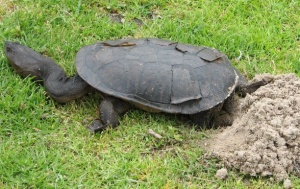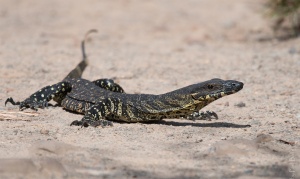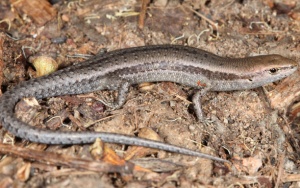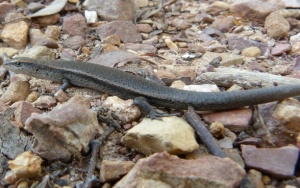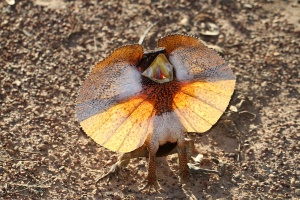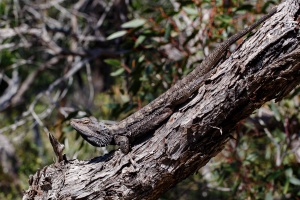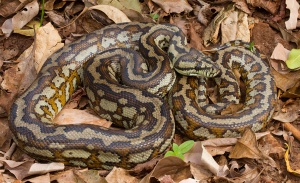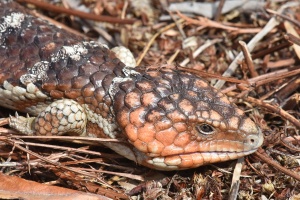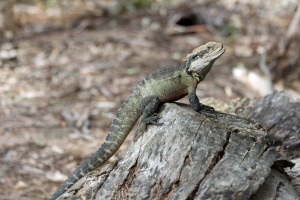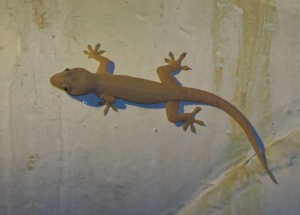Jen Sutfin
Oblong Turtle
The Oblong turtle (Chelodina oblonga) occurs in Northern WA and the Northern Territory. This species is also known as Southwestern snaked-neck turtle (Chelodina colliei) in southwest Western Australia.
The original specimen collected and given the name Chelodina oblonga is now thought to be from a species of long necked turtle found in northern WA and the Northern Territory, the Northern Long-necked turtle (Macrochelodina rugosa). The first specimen of the oblong turtle seen in southwest WA was originally classified as Chelodina colliei.
The carapace (upper shell) ranges in color from light brown to black. The olive to gray neck is thick, with blunt rounded tubercles. The head is large and flat with a protruding snout and an unnotched upper jaw.
Size
Adult Shell 30 - 40 cm long.
Lace Monitor
Found in two broad forms. The main form is dark grey to dull blueish-black with numerous, scattered, cream-colored spots. The snout is marked with prominent black and yellow bands extending under the chin and neck. The tail has narrow black and cream bands which are narrow and get wider towards the end of the tail.
The other type, known as Bells form, is typically found in dryer parts of NSW and Queensland. It has broad, black and yellow bands across the body and tail. Close up, these bands are made up of various spotted patterns.
Also known as the Tree Goanna.
Size
About 55cm long (head and body); 140 cm long (head to tail). Some may grow up to 2.1 m long (head to tail).
Garden Skink Southern
Grey-brown to bronze, with a dark stripe running along each side of its body from its nostril, across its eye to its tail, getting wider from its front legs. Its body pales below the stripe to a cream belly.
This species has a ‘heavier’ looking body and a more obvious stripe running along its sides, compared to the Northern Garden Skink.
Size
8 - 10 cm (nose to end of tail).
Garden Skink Northern
Grey-brown to bronze, with a dark stripe running along each side of its body from its nostril, across its eye to its tail, getting wider from its front legs. Its body pales below the stripe to a cream belly.
This species has a lighter body with a less obvious stripe running along its sides than the Southern Garden Skink.
Size
8 - 10 cm (nose to end of tail).
Frill-necked Lizard
A grey-brown to orange-brown body, which blends well with tree bark. The frill around its neck is more brightly coloured, ranging from yellow to black, mixed with orange and red. Males have a black belly.
Its frill usually lies folded around its shoulders and neck, but as it is connected to its mouth muscles, when its jaw opens wide (such as in alarm), the frill lifts up around its head. Its body is relatively short with a long neck and tail.
Size
70 – 95 cm long (from its snout to the end of its tail) two-thirds of which is its tail. Males are bigger than females. Its frill is 20 – 25 cm in diameter.
Eastern Bearded Dragon
Mottled grey with some yellow tones. There are paired pale blotches along the spine. A grey/brown stripe is found behind the eye to the ear. The underside is also grey with darker circles. Often seen with its mouth open which is yellow in colour. It has a spiny body and tail particularly on the side of the body.
Size
Up to 67 cm long.
Carpet Python
Carpet pythons are extremely variable in colour and pattern (often have pale, dark-edged blotches, stripes or cross bands).
Seven geographical subspecies are recognised as carpet pythons are extremely diverse in appearance. The Northern Territory form (Morelia spilota variegat) is different from the other subspecies because it is a beige or brown colour with blackish or grey blotches and bright gold, yellow and rust colour forms in regional areas. This subspecies is about 2.5m long on average.
They have row of deep pits run along the lower jaw, and small scales present on the top of the head. This species can grow greater than 3 m in length, and although non-venomous, they possess powerful jaws and constricting capability.
Size
2 - 4 m length; 15 kg weight.
Bobtail
Olive brown to black and has irregular pale bands on the body and tail. The head is often lighter in colour and can have orange flecks on the top and sides.
There are four subspecies with some variations:
- Eastern Bobtail (Tiliqua rugosa aspera) Similar to western bobtail but with a darker belly, larger body scales and a shorter fatter tail
- Western Bobtail (Tiliqua rugosa rugosa) Similar to eastern and northern but paler belly and longer tail, larger ear and pale irregular bands on the back
- Rottnest Island Bobtail (Tiliqua rugosa konowi) Yellow belly.
- Northern Bobtail (Tiliqua rugosa palarra) Similar to western bobtail with a smaller ear and usually no pale irregular bands on the back
Size
Total length 45cm.
Australian Water Dragon
Grey, grey-brown to olive green body with patches of cream. It has black bands running across its body and tail and a "crest" of spines which start on its head and extend down its back and along its tail. Its belly is creamy-white to creamy brown-grey and the larger, breeding males have a red-orange chest and throat. One of two subspecies also has a broad black stripe running from behind its eye to its ear. It has long, powerful legs and a long, strong tail with flattened sides to assist with swimming. There are loose folds of skin under its jaw.
Juveniles are light brown and their head and feet appear large for their body size.
Size
Around 80 - 90 cm long (nose to end of tail) two-thirds of which is tail. Males are bigger than females.
Asian House Gecko
A fawn to grey body with some mottling. It can change its colour from paler at night to darker during the day. Its tail can have a slightly flattened appearance and has small spines arranged in bands. It has bulging eyes with no eyelids.
Size
Body about 6 cm with tail 10 cm.

